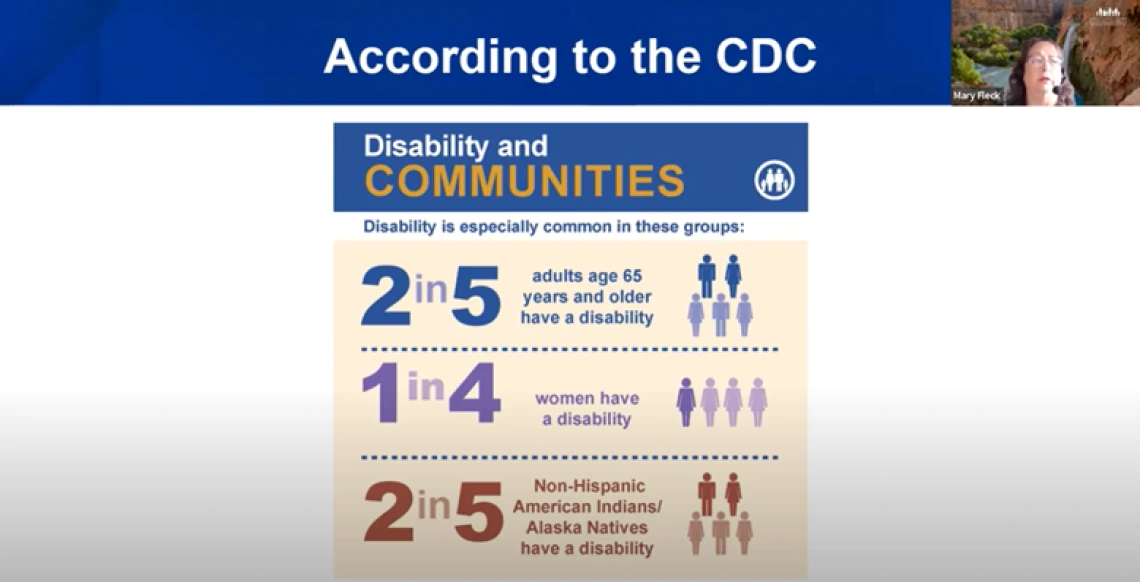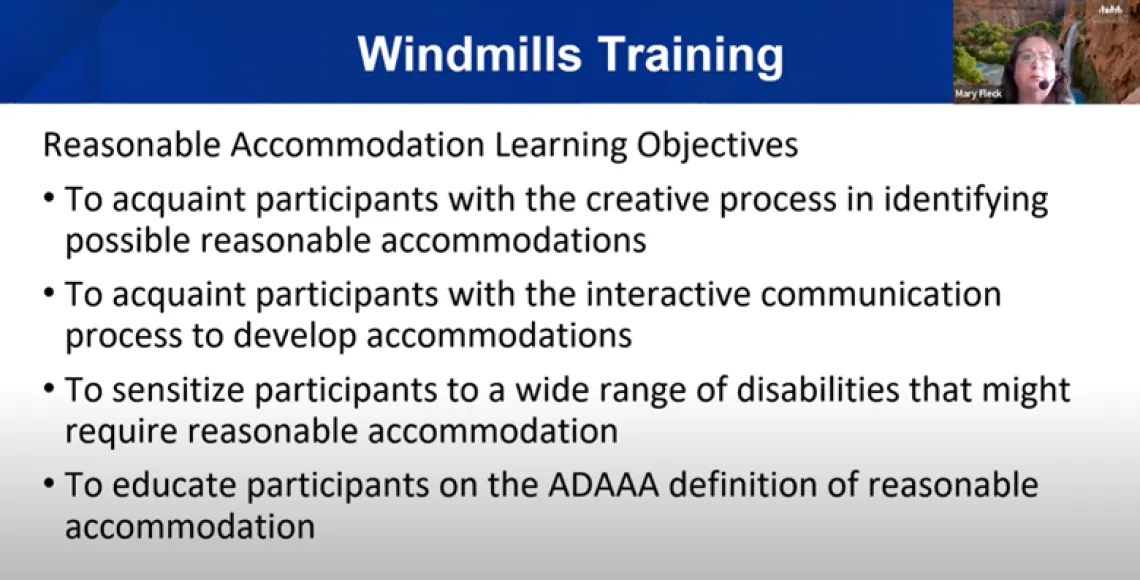National Disability Employment Awareness Month Event Recap: Windmill Training

As part of National Disability Employment Awareness Month, the Employment First Initiative and Vocational Rehabilitation hosted four webinars about how to better include people with disabilities in the workplace, called Windmill Trainings. These interactive presentations focused on how people with disabilities can not only contribute to a workplace, but excel and thrive. People with disabilities of all kinds can help make a workplace more inclusive and creative. With the right mindset and guidance, employers, counselors, and others who work with people with disabilities can make the process of getting and keeping a job easier — for the benefit of everyone.
“Every October is National Disability Employment Awareness Month, or NDEAM. Through the Employment First Initiative in Arizona we’ve partnered with the Developmental Disability Network and Association of People Supporting Employment First throughout the month of October. One of those events is Windmill trainings every Wednesday [in October],” says Heather Wolff, Statewide coordinator for Project SEARCH and Employment Initiatives.
“The Windmill training program is a highly interactive training that empowers and equips employment professionals to help businesses through virtual and in-person training to become more inclusive of individuals with disabilities in the workplace,” Wolff explains. These webinars are not simple presentations, but encourage participants to ask questions and discuss the material — both with the larger group and with smaller breakout groups.
“There’s been a lot of focus around employers and their Diversity, Equity, and Inclusion missions, so a lot of employers are trying to diversify their workforce for the betterment of all companies and employers. Hiring a workforce of people with disabilities will make a better workforce,” says Wolff.
Session 1: Matrix Profiles
The series consisted of four webinars taking place every Wednesday in October. The first was titled “Matrix Profiles”. It began by establishing some facts about the disability community. For example, according to the Center for Disease Control, around 26% of adults in the US have some type of disability. Disabilities in mobility, cognition, and hearing are among the most common. The webinar then proceeded to examine some stereotypes related to disability, like how people with certain disabilities are considered to be predisposed for or against certain jobs. These assumptions are based on outdated and incorrect notions of disability. While they certainly do sometimes still occur, progress is being made to move toward a more individualized system of hiring people with disabilities. In this system, the person with a disability’s interests and aspirations are moved to the forefront, with employers working with them to provide the accommodations they need to be successful.

A screenshot from the first Windmill session, “Matrix Profiles”. Facilitator Mary Fleck, Vocational Rehabilitation Regional Program Manager for Southern Arizona, explains stats from the CDC about disability communities in the US.
Session 2: Reasonable Accommodations
Building off of the themes of the first, the second session was called “Reasonable Accommodations”. As the webinar explained, the Americans with Disabilities Act defines a reasonable accommodation as: “Any change to the application or hiring process, the job, the way the job is done, or the work environment that allows a person with a disability who is qualified for the job to perform the essential functions of that job and enjoy equal employment opportunities. Accommodations are considered ‘reasonable’ if they do not create an undue hardship or a direct threat.”
One major takeaway from this webinar was that it is important for employers and employees to be in open communication about what the employee needs to do their job. Some employers may be hesitant to ask potential employees if they can fulfill the job requirements with or without reasonable accommodations, possibly because they are anxious about being perceived as discriminatory. However, it is not discriminatory to ask if an applicant has everything they need to perform the job well.
_____________________________________
“Reasonable Accommodations in the Workplace | ADA National Network.” Adata.org, ADA National Network, 2018, adata.org/factsheet/reasonable-accommodations-workplace. Accessed 3 Nov. 2022.

A screenshot from the second Windmill session, “Reasonable Accommodations”. Facilitator Mary Fleck goes over the learning objectives for the session.
Session 3: Whose Fault?
The third webinar explored a practical scenario in which to apply the principles of the first two sessions. It was called “Whose Fault?”. In it, participants were presented with a scenario in which a person with a disability interviewing for a job did not get the accommodations they needed. As a result, the interview did not go well and the interviewee was not asked to return, despite having the qualifications and skills for the job.
There were multiple opportunities for communication that were missed on the part of several parties. The interviewee missed what could have been a promising job opportunity, and the interviewers lost the opportunity to have a promising employee. First and foremost, the employers did not ask the interviewee if they required accommodations. It is the responsibility of the employer to ask if accommodations are necessary. The employee can then choose to disclose their disability if necessary and the accommodations they would need.
Session 4: Pick a Disability
The fourth and final webinar in the series, called “Pick a Disability”, touched on the experiences of celebrities with disabilities, including musicians, actors, and fashion designers. This was to prove that not only are people with disabilities more numerous than one might assume, but also that they are thriving even in some of the most competitive fields.
These webinars speak to larger issues facing people with disabilities in the workplace. Sometimes, there can be a reluctance to work with or hire people with disabilities because it is assumed they will not perform as well as abled people. In actuality, the experiences and aptitudes of people with disabilities are as varied as anyone. Given the chance, people with disabilities can be an integral part of a thriving workplace.
Recordings of all sessions will be uploaded to YouTube this month.
